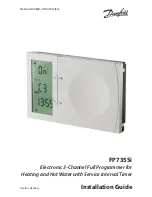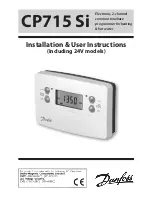
motor on for both directions or for the forward direction only.
REV --- Depending on the motor driver type configured, this signal reverses the motor
direction or it activates the motor in reverse direction.
SPD1 --- This signal is active while the ACU wants to run the motor slowly.
SPD2 --- This signal is active while the ACU wants to run the motor fast.
RESET --- The ACU activates this signal for 800 msecs if the operator clicks RESET. The
signal may be cabled to an input of the motor driver which resets latching faults.
FAULT --- The ACU monitors this signal all the time. The signal is low-active, i.e. the ACU
expects current flowing through the optocoupler while the driver is OK, if the circuit is
opened, the ACU signals a fault and stops the motor. If the motor driver does not provide a
fault signal, the clamps of the FAULT input must be wired to 0V/24V otherwise the ACU will
not move the motor!
The ACU knows two different configuration modes to control a motor driver. They are called 'DIR-
START' and 'DUAL-START'. In 'DIR-START' mode, the 'FWD' signal switches the motor on/off, the
'REV' signal controls the motor direction. This is the configuration many frequency inverters use.
In 'DUAL-START' mode, the 'FWD' signal switches the motor on in forward direction, 'REV'
activates the motor in reverse direction. This configuration mode is convenient to control a motor
with relays.
The speed select signal SP1 and SPD2 actually are the same signal, but with different logical
polarity. For most motor drivers it is sufficient to connect one of these two signals, select the one
which matches the polarity the motor driver expects.
Remark for operation in the northern/southern hemisphere:
Look 'through the antenna' to the satellite for the correct orientation of left/right, up/down and
clock/counterclockwise.
axis
northern hemisphere
southern
hemisphere
azimuth
FWD moves the antenna to the right, the position sensor must
increasing the measured value. FWD moves the antenna
'westward'
The center direction to the satellite orbit is 180°. Turning angles are between 0 to 360° | FWD
moves the antenna to the right, the position sensor must increasing the measured value. FWD
moves the antenna 'eastward' The center direction to the satellite orbit is 0°. Turning angles are
between -180 to +180° | | elevation | FWD moves the antenna up, the position sensor must
increasing the measured value. Turning angles are between 0 to 90° | FWD moves the antenna
up, the position sensor must increasing the measured value. Turning angles are between 0 to
90° | | polarization | FWD turns the feed clockwise, the position sensor must increasing the
measured value. Turning angles are between -180 to 180° | FWD turns the feed clockwise, the
position sensor must increasing the measured value. Turning angles are between -180 to 180° |
sat-nms ACUs having the "ACU-ODM Software Upgrade Step Track" installed are capable to
track a satellite's position. The
following paragraph
describes how the sat-nms steptrack
algorithm works. Beside plain step track, this option includes the so called
adaptive tracking
and a
file/program tracking
facility as well. While step track and adaptive tracking require a beacon
(C) 2022, SatService GmbH
www.satnms.com
ACU-ODM-UM-2209 Page 61/73













































